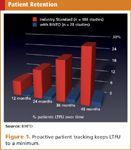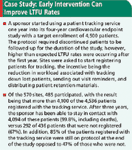Lost to Follow-Up Survey Results
A 10-fold reduction in LTFU rates was observed in clinical trials that used patient tracking services.
New analysis has shown that proactively adopting patient tracking solutions can dramatically lower lost to follow-up (LTFU) rates and increase the efficiency of existing retention activities, but the systematic adoption of these services to support long-term trials is not yet widespread. With many clinical trials conducted today requiring long-term patient follow-up, it is important for sponsors to have access to cost-effective solutions to increase patient retention and reduce LTFU rates.
Patient tracking services are independent, centralized registries of clinical trial subjects that actively maintain and update patient contact details, and allow sponsors to rapidly communicate with study subjects while protecting each subject's anonymity. Tracking services have a relationship with each clinical trial subject that is independent of any relationship with a trial, site, or sponsor—usually obtaining consent for regular, enduring communication even in the event that a patient has completed the study or withdrawn consent for study participation.

In contrast to sites that have limited resources to apply to patient tracking, patient tracking services apply centralized, dedicated resources, processes, and systems to ensure that patients remain highly contactable. This involves the systematic collection and verification of detailed patient contact information at the time of patient registration. It also involves systematic, regular patient outreach that frequently involves multiple phone calls, often after hours. Patient tracking services also have access to a variety of third party databases to locate patients that may have moved suddenly or died. The centralized nature of patient tracking services allows sponsors to recontact patients rapidly across all sites in all regions—avoiding problems associated with variability in site responsiveness. Since patient tracking services establish a relationship with patients that exists independently of sites and obtain consent that is independent of the study they can easily recontact patients that have withdrawn consent from the study, or have separated from a site on unfavorable terms—a situation that can occur when patients experience significant side effects, or fail to meet their treatment expectations while participating in the trial. BINTO, a provider of international patient tracking services, routinely maintains active contact with patients during a study and up to five years after a study has completed.
Recently, BINTO conducted a survey of project managers across the globe to quantify the challenges of LTFU in clinical trials. Not surprisingly, rates of LTFU tended to become significantly greater over time, ranging from 7.3% after 12 months up to 27% after 48 months. The most striking finding however, was that projects using proactive patient tracking solutions experienced dramatically reduced LTFU rates, at only 0.8% after 12 months rising to only 2.4% after 48 months. More information about the survey can be found in the Study Results sidebar.

Study Results Highlight a Solution for LTFU in Long-Term Studies
Failing to account for the welfare of patients during a study can affect the validity of its safety final results1—particularly when looking for relatively low numbers of safety events in comparison to the number of patients LTFU. For example, the conclusions drawn from a study of 1,000 patients that resulted in two deaths and 48 LTFU patients are limited regarding a mortality rate. As pharmaceutical companies strive to quantify rarer safety signals, even LTFU rates as low as 3% or 4% could invalidate the investment associated with a five-year safety trial. Over 92% of project managers surveyed indicated that they viewed proactive patient tracking as a valuable or very valuable tool for their studies, although less than 13% of long-term studies actually employed such a solution.
A sponsor company running a global Phase IIIb study with a two-year follow-up, developed problems with LTFU within three months of start-up. Seeking to address this problem rapidly, the sponsor deployed a patient tracking solution resulting in LTFU less than 1% at the end of the study. More than 12 months after the study was completed, the sponsor was still tracking 6,247 of the 6,296 patients (99.2%) enrolled. The sponsor is now planning to use its continued access to these patients to rapidly enroll a new Phase III trial for a follow-on compound—potentially saving more than 18 months of recruitment time.

Figure 1. Proactive patient tracking keeps LTFU to a minimum.
Spurred by the fallout over Merck's Vioxx (rofecoxib), which was withdrawn from sale in 2004 after evidence emerged that raised concerns over the drug's cardiovascular safety, extensions to Phase III trials, or Phase IIIb/IV studies are increasingly required by regulatory authorities. Both US Food and Drug Administration2 and European Medicines Agency3 have been increasing their demands on pharmaceutical sponsors for long term drug safety monitoring and risk management research.
In addition to reducing LTFU during a study, patient tracking services continue to add value by maintaining contact with patients after study close-out and thereby reducing the need for costly study extensions. Sponsors that are able to recontact patients after a study is completed are able to address long-term safety concerns using data gathered from patients with randomized exposure to their drug. Sponsors that are unable to recontact their patients must restart long-term safety studies from scratch, rather than revisit patients that were previously exposed to their investigational product in earlier years—adding significant cost to their post-marketing efforts and impairing their product's ability to obtain market access in the fastest way possible.
In the same survey, project managers were asked how easily they could contact patients one year following the closure of a study—in response to a safety concern that appeared during final analysis or a regulatory request for example. Overall, project managers felt that less than 15% of patients could be recontacted without a tracking service, contrasting with the over 99% 12-month patient re-contact rates obtained when a tracking system was used.
A second sponsor who contributed to the survey, had chosen to use a patient tracking service for an oncology study with 12-month follow-up. During subsequent regulatory review, the sponsor was asked to provide two-year survival data in addition to the original results obtained during their trial. The sponsor was able to recontact patients within a few weeks—accounting for 99.7% of their randomized patients two-years after initial treatment, and allowing the sponsor to address regulatory concerns rapidly without the cost and time associated with starting a new study or re-opening sites.
In addition to reducing LTFU during a study, patient tracking services can increase the effectiveness of patient retention efforts. Traditionally, to maximize retention rates, many sponsors choose to have sites make phone calls to patients between visits and/or provide sites with patient retention materials to keep subjects engaged. In addition to allowing sponsors to reduce LTFU and facilitate long-term patient data capture, patient tracking services ensuring that retention materials, reminders, newsletters, and other interventions are reliably delivered to study subjects.
Project manager responses suggests that while 65% of long-term studies require sites to make interim phone calls, less than half of these calls actually connect with patients due to a lack of available resources/infrastructure at sites.
The analysis also suggested that while approximately 5% of a study's budget is normally allocated to the development of patient retention and compliance support materials, less than half of these materials are actually received by the patients. In contrast, studies that employed patient tracking services to call patients by telephone or distribute retention materials by mail directly to patients achieved call connection rates in excess of 90%, and material delivery rates in excess of 94%. Maximizing the cost-effectiveness of retention strategies is even more critical in this era of tight economic focus.4
A sponsor started using a patient tracking service one year into its four-year study with a target enrollment of 4,500 patients, when higher than expected patient drop-out and LTFU rates were observed. Subsequently, 90% of patients were registered with the patient tracking service. The sponsor chose to reduce the burden on sites associated with the distribution of retention materials by using the tracking service to make interim phone calls and distribute study newsletters. After three years, the sponsor has been able to stay in contact with 99% of registered patients, compared with only 67% of those who were not registered. In addition 85% of the patients registered with the tracking service were still on protocol at the end of the study opposed to 47% of those who were not. Further details of this case study are available in the Case Study sidebar.

Case Study: Early Intervention Can Improve LTFU Rates
As study follow-up periods get longer there is an increased risk that sites may not be able to stay in touch with their patients. Unfortunately, since most long-term studies are conducted to quantify infrequent safety or clinical outcomes, the inability to account for even small numbers of patients can cause a study to fail. Results show that proactive patient tracking can have a lasting and positive impact on reducing the detrimental effect of patient drop out and LTFU.
Melissa Easy is Director, Strategic Accounts, e-mail: melissa.easy@binto.org, and William Hare is General Counsel both at BINTO USA Inc., 66 Witherspoon Street, Suite 317, Princeton, NJ.
References
1. V. Kristman, M. Manno, and P. Cote, "Loss to Follow-Up in Cohort Studies: How Much is Too Much?," European Journal of Epidemiology, 19 (8) 751-760 (2004).
2. Food and Drug Administration, Postmarket Requirements and Commitments, http://www.fda.gov/Drugs/GuidanceComplianceRegulatoryInformation/Post-marketingPhaseIVCommitments/ucm064633.htm.
3. European Medicines Agency, Pharmacovigilance for Medicinal Products for Human Use, Chapter 3, Part I, Volume 9A of Eudralex, http://ec.europa.eu/health/documents/eudralex/vol-9/index_en.htm.
4. Elizabeth Moench, "The Business of Recruitment," Applied Clinical Trials, Trends in Subject Recruitment, insert, March 2009, 8-9.

Newsletter
Stay current in clinical research with Applied Clinical Trials, providing expert insights, regulatory updates, and practical strategies for successful clinical trial design and execution.
Improving Relationships and Diversifying the Site Selection Process
April 17th 2025In this episode of the Applied Clinical Trials Podcast, Liz Beatty, co-founder and chief strategy officer, Inato, discusses a number of topics around site engagement including community-based sites, the role of technology in improving site/sponsor relationships, how increased operational costs are impacting the industry, and more.